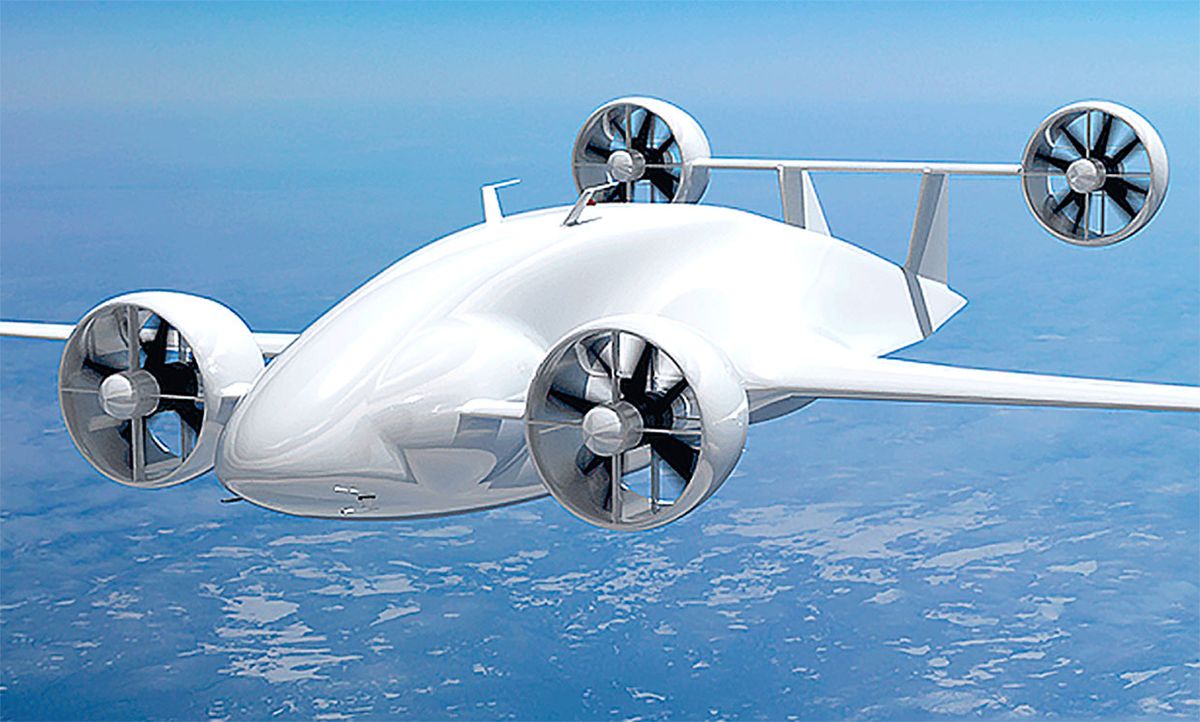For a pilot, there really is no substitute for knowing what’s in front of you. In a drone, that capability is known as detect-and-avoid, and so far, no drone has cleared the bar.
Sabrewing, a startup in Camarillo, Calif., may well be the first to do it. It’s working on a cargo-carrying drone that’s due to begin test flights in 2020.
“Even the military does it only in a kind of rudimentary way, say with a camera system; our system has to provide a way for the aircraft to autonomously avoid obstacles,” says Ed De Reyes, the chief executive of Sabrewing. One of the drone’s first applications will likely be for the U.S. military, which wants pilotless systems to ferry supplies to outposts and to evacuate wounded soldiers under circumstances too dangerous to justify sending in manned aircraft.
The drone will combine data from a camera, a lidar capable of looking 350 meters ahead, a radar, a forward-looking infrared detector (for landing at night), and a send-and-receive GPS navigation system, known as ADS-B.
“Ours is the first that fuses sensors; the FAA (U.S. Federal Aviation Administration) hasn’t seen a solution like ours,” De Reyes says.
The aircraft is dubbed Rhaegal, after a dragon from the “Game of Thrones” series, and it’s meant to fly itself one day. At first, though, it will require a remote pilot, and the detect-and-avoid system will merely help that pilot out. Reason: The FAA requires any drone over 22 kilograms (50 pounds) to have a remote pilot, and a Rhaegal will weigh up to 1,360 kg (3,000 pounds) when fully loaded.
In the test flights, planned to take place in the Aleutians, a string of islands in Alaska, the drone will hoist 360 kg (800 pounds) when lifting off vertically and a quarter more than that when taking off from a 90-meter runway.
The aircraft will have four ducted fans, powered by motors driven by electricity generated by a Rolls Royce turbine. The wingspan will be 9 meters (30 feet), the length slightly less, the speed up to 180 knots, and the cruising altitude as high as 6.7 kilometers (22,000 feet).

Right now, though, the company is running its wind-tunnel tests on a model scaled to just one-eighth the intended final size.
Other startups are also pursuing cargo-lugging drones. A little more than a year ago we wrote about Natilus, in the Bay Area, which plans to build a humongous seaplane capable of hauling 100 metric tons. Dronamics, in Bulgaria, is aiming at a smaller size. And a Chinese consortium has already test-flown a modified civilian airplane as a drone. But all these aircraft require runways and therefore must be certified by regulators just as an airliner would be: slowly and expensively. In many cases, certification can cost as much as building the aircraft itself.
A vertical-takeoff drone would enjoy certain advantages in certification, particularly if it provided service where no other flights can land.
There is one startup, Elroy, that’s also doing vertical liftoff and landing. “But they are only looking for the last mile, and carrying 150 pounds (68 kg), and we’re 10 times that amount,” De Reyes says. “I don’t know if they’ll have detect-and-avoid, but they’ll stay within the 107 rule, which mandates a maximum altitude of 400 feet, so they’ll have a different certification process, too.”
However, Elroy co-founder Clint Cope tells IEEE Spectrum that those specs will apply only to his company’s demonstrator craft, which will have its first test flight in a few months. “The production airframe we’re building is slated for 500 pounds [of cargo], and it will be flying at the 5,000-10,000 foot [altitude],” he says.
Vertical takeoff and landing can matter not just for soldiers but also to any civilians who live where runways are thin on the ground. The Aleutian Islands, home to Native Alaskans, are a perfect test bed and a potential market.
The plan is to gain experience there with the detect-and-avoid technology. “We’ll do quite a bit of testing in the protected area of Alaska, then in all of Alaska, and then [the FAA] will let us operate in a few routes in the lower U.S.A.,” says De Reyes.
Cargo isn’t as sexy as passenger flight, but it’s an easier sell. De Reyes says that a lot of startups going after the urban air taxi market are now coming to grips with the regulatory barriers they’re facing. Maybe some of them will rip out the upholstery to make room for container racks, so they can carry things rather than people.
Editor’s note: This story was updated on 29 March to include the comment of Elroy co-founder Clint Cope.
Philip E. Ross is a senior editor at IEEE Spectrum. His interests include transportation, energy storage, AI, and the economic aspects of technology. He has a master's degree in international affairs from Columbia University and another, in journalism, from the University of Michigan.



